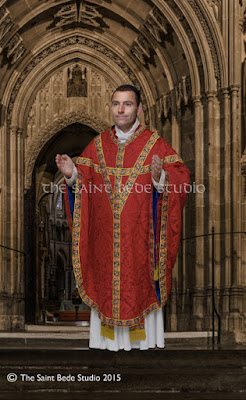PART THREE: CHASUBLES OF THE 16TH CENTURY
 |
Figure 1.
A chasuble made by the Saint Bede Studio
approximating the Borromeon dimensions. |
Frequently, the Studio receives enquiries asking
about the distinctions between the different styles of chasubles. Comments are also often seen on websites which indicate that this
subject matter is still not well-known. Although this has been written
about before on the blog, I wish to present a series of posts
describing the styles of chasuble down the centuries until our own time. These posts ought to be regarded as brief overviews rather than scholarly treatments of the subject matter.
This post concerns the style of chasuble found in the sixteenth century and in particular that form deemed desirable by Saint Charles Borromeo. As has been written about
elsewhere, Saint Charles set down regulations about any number of things pertaining to arrangements of churches and their ministers. From the earliest years of the Church until about the sixteenth century, the conical or bell-shaped chasuble had been the norm for the ministers at the altar. In the thirteenth century, as described in
part two of this series, the shape of that chasuble was slightly modified for the greater convenience of the wearer.
 |
Figure 2.
Detail of a 17th century French painting
depicting the Last Mass of Saint Benedict,
shewing a monk vested in an ample chasuble
of the dimensions recommended by Saint Charles.
Note the albes worn by the celebrant and acolytes
are of linen with close-fitting sleeves
and the narrowest fringe of lace
ornamenting them : very dignified.
At the altar, the celebrant is placing a ciborium
into what appears to be a large hanging pyx. |
From the fifteenth century, however, in various parts of Europe, but particularly northern Europe, vestment makers took it upon themselves to modify the chasuble still further to free-up the celebrant's arms. Thus, even at this early date but only in some places, that ugly shape referred to unkindly as the "fiddleback" began to appear. It is noteworthy that the truncation of the chasuble in this way was never sanctioned by Ecclesiastical authority. Whilst abbreviated chasubles were appearing North of the Alps, Rome retained the Tradition of the ample chasuble, as did Spain.
 |
Figure 3.
Portrait of Saint John Paul II by the Russian artist Natalia Tsarkova
showing the Pope wearing a modern exemplar
of a chasuble according to the Borromeon dimensions. |
Thus it was that Saint Charles, obviously disedified by what he deemed to be unseemly abbreviations of the form of the chasuble, set down regulations for the benefit of his Diocese of Milan. These were the dimensions he believed to be the
minimum in order for a chasuble to conform to Tradition. He prescribed that the chasuble was to be very long, reaching at the back almost to the heels of the wearer and wide enough so that it reached
at least half way between the elbow and the wrist.
 |
| Figure 4. |
The diagram above is a montage produced to help explain the difference
between the ancient conical form and that modified form approved by Saint
Charles. Note that the bell-shape has been altered by reducing fabric
along the shoulder line of the vestment. Perhaps the most significant variation in chasuble-making of this period, however, was the modification of the angle of the shoulder line, to become far less acute. The modified form leaves the arms of the wearer comparatively free, rather than wrapping itself around the wearer as the ancient conical form did (see figures 2 and 3 for chasubles in this modified form).
Saint Charles did not draw-up designs for chasubles, nor did he specify how they were to be ornamented. His concern was that they remain ample, according to Tradition. The different looms on which fabric was woven determined, of course, the
width of the chasuble. This is why historic paintings, drawings, sculptures etc sometimes shew chasubles of the Borromeon form which, whilst quite long, nevertheless do not reach beyond the midpoint of the forearm. There is great variation.
Lastly, we are pleased to include this detail from Beccafumi's painting
The Miraculous Communion of Saint Catherine of Siena, circa 1515. This shews the form of chasuble that was to be found in Italy at the beginning of the sixteenth century. It closely corresponds to the dimensions prescribed by Saint Charles 80 years later. Note that, unlike the conical form, described in our first two posts, this chasuble does not fold upward from the lower edge, but instead, sits on the wearer.
 |
| Figure 5. |

















































